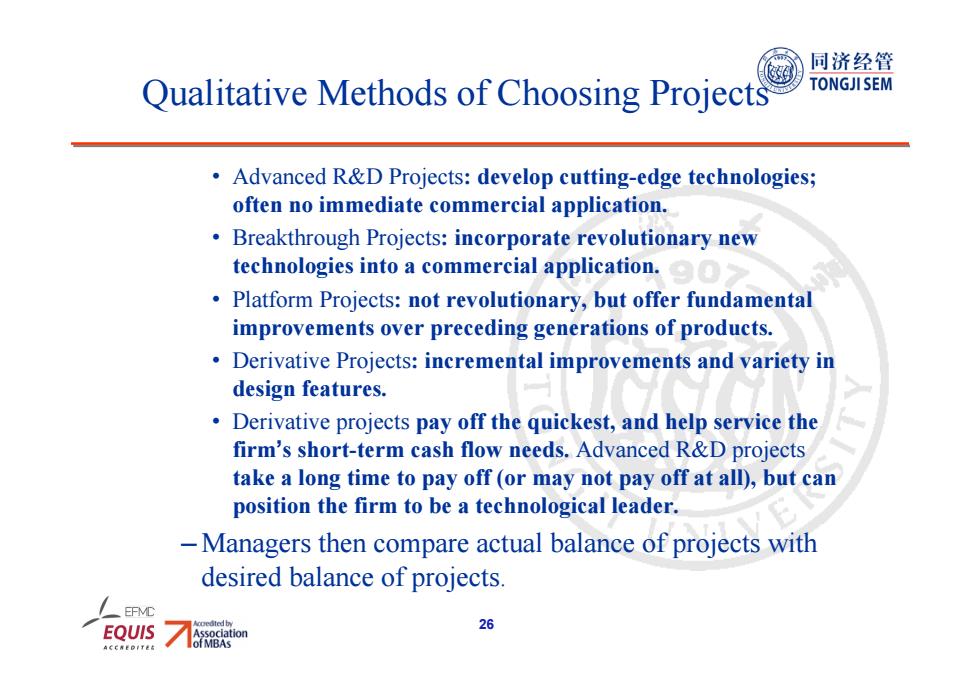
同济经管 Qualitative Methods of Choosing Projects TONGJI SEM Advanced R&D Projects:develop cutting-edge technologies; often no immediate commercial application. Breakthrough Projects:incorporate revolutionary new technologies into a commercial application. Platform Projects:not revolutionary,but offer fundamental improvements over preceding generations of products. Derivative Projects:incremental improvements and variety in design features. Derivative projects pay off the quickest,and help service the firm's short-term cash flow needs.Advanced R&D projects take a long time to pay off(or may not pay off at all),but can position the firm to be a technological leader -Managers then compare actual balance of projects with desired balance of projects. EFMC EQUIS 26
26 Qualitative Methods of Choosing Projects • Advanced R&D Projects: develop cutting-edge technologies; often no immediate commercial application. • Breakthrough Projects: incorporate revolutionary new technologies into a commercial application. • Platform Projects: not revolutionary, but offer fundamental improvements over preceding generations of products. • Derivative Projects: incremental improvements and variety in design features. • Derivative projects pay off the quickest, and help service the firm’s short-term cash flow needs. Advanced R&D projects take a long time to pay off (or may not pay off at all), but can position the firm to be a technological leader. – Managers then compare actual balance of projects with desired balance of projects
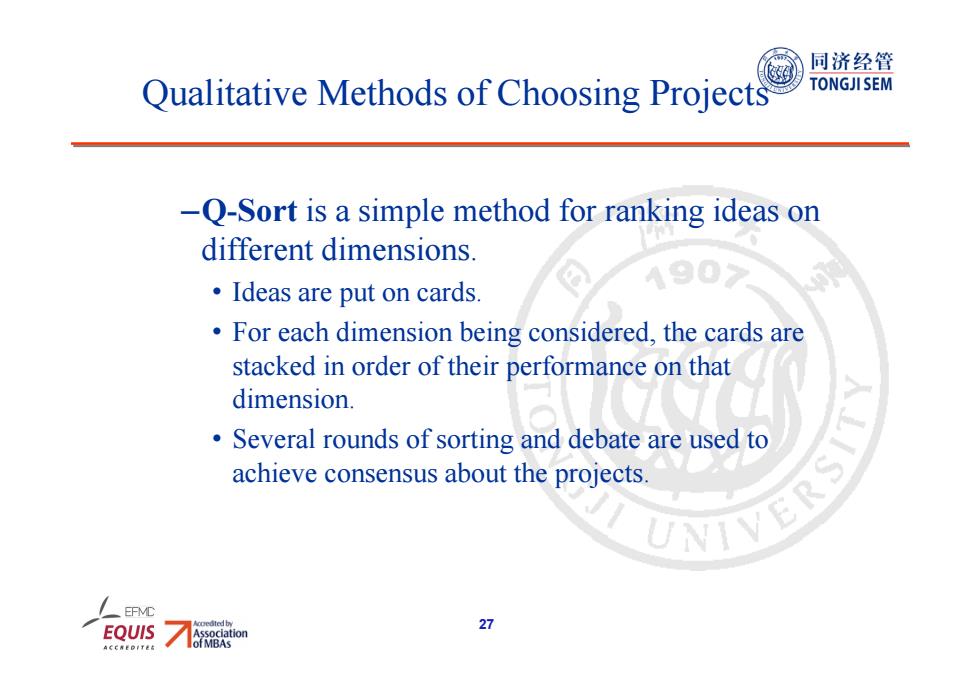
同济经管 Qualitative Methods of Choosing Projects TONGJI SEM -Q-Sort is a simple method for ranking ideas on different dimensions. A90 Ideas are put on cards. For each dimension being considered,the cards are stacked in order of their performance on that dimension Several rounds of sorting and debate are used to achieve consensus about the projects. EOUIS 27
27 Qualitative Methods of Choosing Projects –Q-Sort is a simple method for ranking ideas on different dimensions. • Ideas are put on cards. • For each dimension being considered, the cards are stacked in order of their performance on that dimension. • Several rounds of sorting and debate are used to achieve consensus about the projects
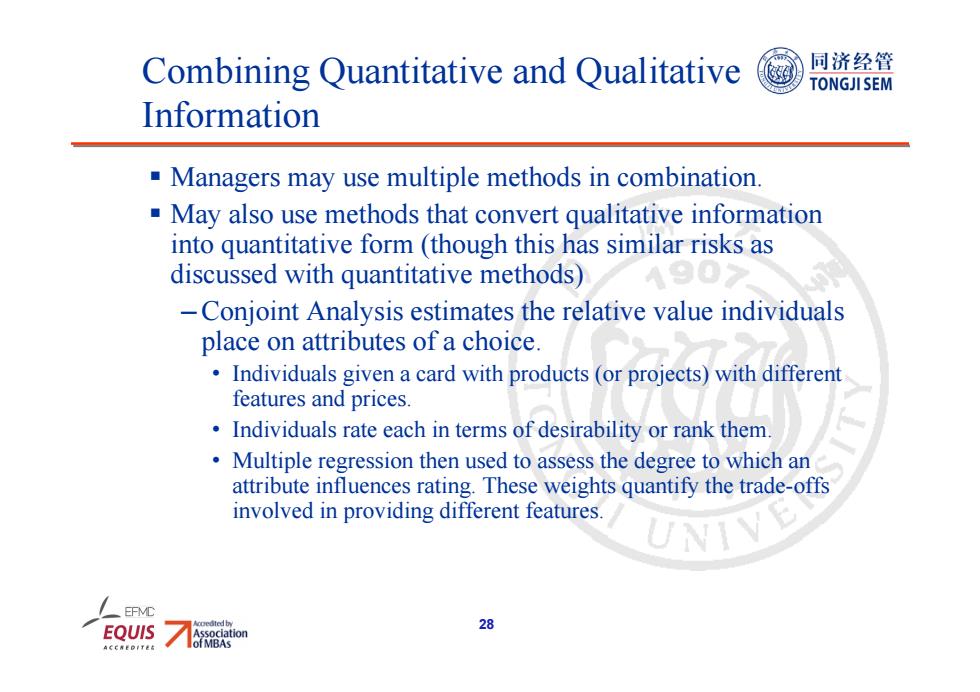
Combining Quantitative and Qualitative 同济经管 TONGJI SEM Information Managers may use multiple methods in combination. May also use methods that convert qualitative information into quantitative form(though this has similar risks as discussed with quantitative methods) -Conjoint Analysis estimates the relative value individuals place on attributes of a choice. Individuals given a card with products (or projects)with different features and prices. Individuals rate each in terms of desirability or rank them Multiple regression then used to assess the degree to which an attribute influences rating.These weights quantify the trade-offs involved in providing different features. EQUIS 28
28 Combining Quantitative and Qualitative Information Managers may use multiple methods in combination. May also use methods that convert qualitative information into quantitative form (though this has similar risks as discussed with quantitative methods) – Conjoint Analysis estimates the relative value individuals place on attributes of a choice. • Individuals given a card with products (or projects) with different features and prices. • Individuals rate each in terms of desirability or rank them. • Multiple regression then used to assess the degree to which an attribute influences rating. These weights quantify the trade-offs involved in providing different features
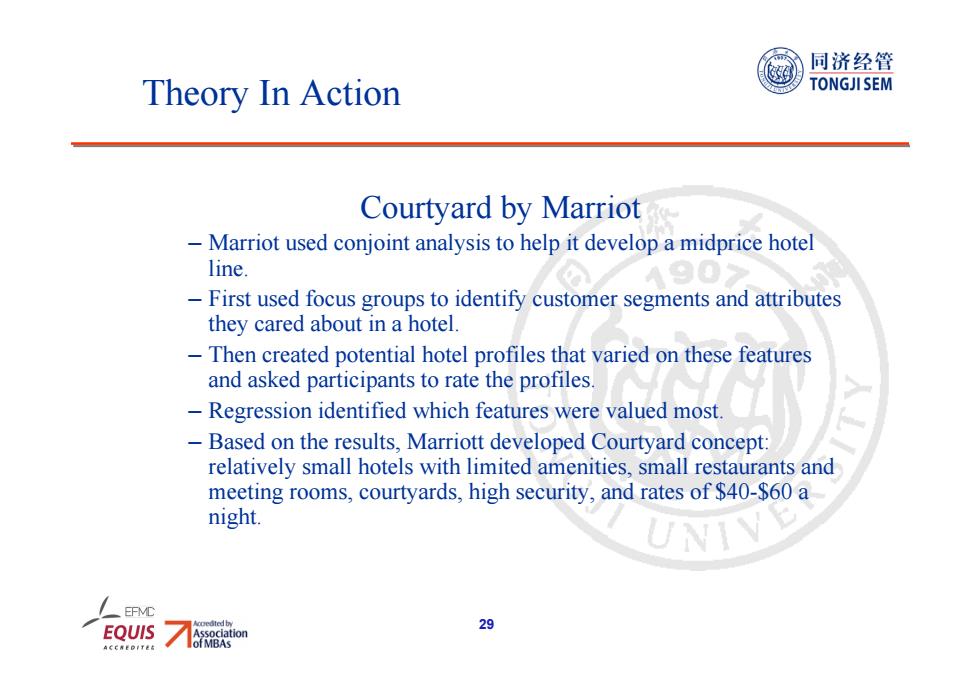
同济经管 Theory In Action TONGJI SEM Courtyard by Marriot Marriot used conjoint analysis to help it develop a midprice hotel line. A9O -First used focus groups to identify customer segments and attributes they cared about in a hotel. Then created potential hotel profiles that varied on these features and asked participants to rate the profiles. -Regression identified which features were valued most -Based on the results,Marriott developed Courtyard concept: relatively small hotels with limited amenities,small restaurants and meeting rooms,courtyards,high security,and rates of $40-$60 a night. EOUIS 29
29 Courtyard by Marriot – Marriot used conjoint analysis to help it develop a midprice hotel line. – First used focus groups to identify customer segments and attributes they cared about in a hotel. – Then created potential hotel profiles that varied on these features and asked participants to rate the profiles. – Regression identified which features were valued most. – Based on the results, Marriott developed Courtyard concept: relatively small hotels with limited amenities, small restaurants and meeting rooms, courtyards, high security, and rates of $40-$60 a night. Theory In Action
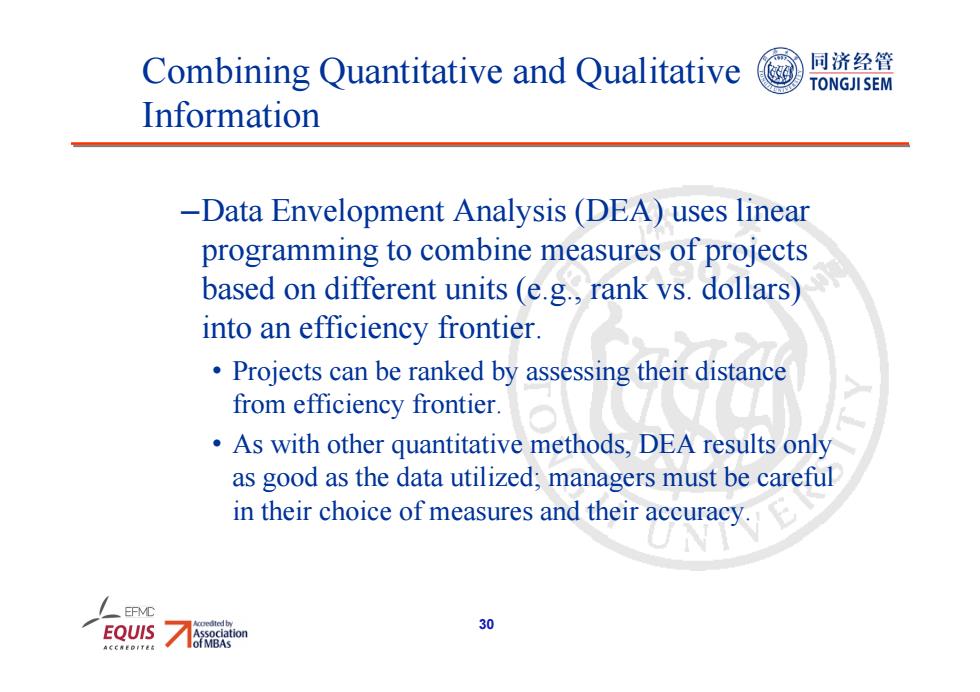
Combining Quantitative and Qualitative 同济经管 TONGJI SEM Information -Data Envelopment Analysis(DEA)uses linear programming to combine measures of projects based on different units(e.g.,rank vs.dollars) into an efficiency frontier. Projects can be ranked by assessing their distance from efficiency frontier. As with other quantitative methods,DEA results only as good as the data utilized;managers must be careful in their choice of measures and their accuracy. EQUIS 30
30 Combining Quantitative and Qualitative Information –Data Envelopment Analysis (DEA) uses linear programming to combine measures of projects based on different units (e.g., rank vs. dollars) into an efficiency frontier. • Projects can be ranked by assessing their distance from efficiency frontier. • As with other quantitative methods, DEA results only as good as the data utilized; managers must be careful in their choice of measures and their accuracy